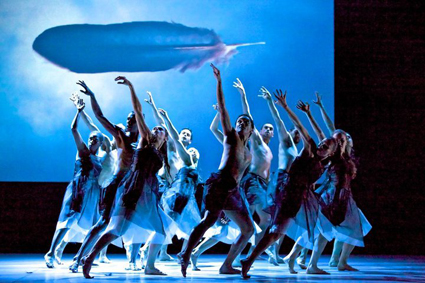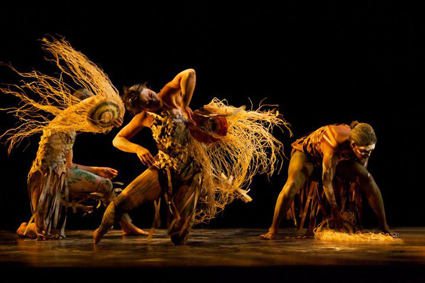restoring culture: the dance of images & artefacts
keith gallasch: bangarra dance theatre, of earth & sky

‘Feather’ from Riley
photo Andy Solo
‘Feather’ from Riley
SOFT WHITE CLOUDS DRIFT ACROSS BLUE SKY. OUT OF THE DARK BELOW, ON THEIR BACKS, CRAWLING BUT TORSO AND FACE UP, CREATURES SLIDE INTO DIM LIGHT. THEY WALK, BUT BEND THEIR KNEES TO THE GROUND, ARMS RIGHT-ANGLING OUT. LIKE STRANGE, EMERGENT ANIMALS THEY FORM BENEATH THE IMAGE OF A BOOMERANG AND TWIST, TURN AND ARCH, PERHAPS AT ONE WITH ITS SHAPE AND IMAGINED FLIGHT. THEY STAND, THE BOOMERANG FADES. ANOTHER CREATURE SCUTTLES THROUGH THE DARK AND A LOCUST FORMS BEFORE US, AGAIN ICONICALLY SUSPENDED IN CLEAR SKY.
In Bangarra Dance Theatre’s new season, Of Earth & Sky, the company is introducing a promising new Indigenous choreographer, Daniel Riley McKinley (24 years old, four years with the company) who has chosen as the subject and inspiration for his first major work the cloud series by the late Wiradjuri/Kamilaroi photographer and filmmaker Michael Riley (RT76, p20; RT77, p15). McKinley has selected six of the 10 images—feather, locust, bible, boomerang, broken wing, angel—objects suspended mysteriously in blue skies, and which for him relate most directly to Aboriginal culture. Omitted, for example, is Riley’s jersey cow, an almost comically displaced figure but equally indicative of ruinous environmental and cultural invasion.
Each image is projected onto a large screen behind the dancers and one by one is graphically realized and interpreted. Beneath the locust, dancers’ arms become wings as they cluster in groups and then en masse, to a buzzing electronic score and a riffing, insistent piano. Curiously, the choreography manages to express not only a locust swarm, but also the gestures of those protecting themselves from it in a series of alternations. The plague escalates into highly organized frenzy of sound and movement—straight lines and rapid circles, a fear-inducing army. Just as suddenly it stops. Something else scuttles across the stage.
The Bible, worn leather cover, hovers and a curiously abstract ritual of oppression ensues, hauntingly embodied by Elma Kris and soon multiplied in a row of other women on a diagonal across the stage, gold crosses emblazoned on—or ‘branded on’—their backs. They kneel, hands pushed up behind their backs, as if bound, and their heads drop to the earth. They rise, they stand, walk, go down on their knees as an eerie, distant female choir is heard buried deep in the music. They stand, elbows above their heads, hands behind their heads, palm to palm, like a distorted image of prayer or tortured angel wings, passing before us across the front of the stage and into the dark. The psychological pain induced by an alien religion that converts by bondage is palpable in the sheer otherness of the strange patterns that McKinley makes.
The Bible is replace by a fragmented view of a graveyard sculpture, the Angel. In another powerful episode two men with whitened bodies appear, one borne elegantly on the other’s shoulder, his body in a gentle arc, two bodies as one: is this the Angel? As the carried body extends further out, it’s as if gravity is being defeated. The bodies twist and roles are reversed, carried becomes carrier in the most sinuous of moves, as if on air, in this the most ambiguous of McKinley’s episodes. It’s as if he’s asking, are there angels, divine helpers, and can they be as beautiful and strange as this—and Waangenga Blanco and Leonard Mickelo can answer this for him.
In a mysterious return to the Bible, men in short skirts, the same gold crosses extending the length of their backs, dancing wide-stanced, like Pacific Islanders perhaps, execute obscure tasks, move angularly and fluently dance in a circle of blue light, almost warrior-like in contrast to the equivalent female episode—an image here of some kind of accommodation? McKinley writes in his program note: “The men represent the other side of the religious experience as an exaggerated religious presence.”
The screen turns white. A woman (Jasmin Sheppard) swathed in feathers crawls across the floor to a low cello growl, her body racked, struggling to rise in a painfully exquisite pattern of elaborate moves that seem to engage every part of the body in the effort as Michael Rlley’s Broken Wing image appears on the screen.
Riley’s Feather replaces Broken Wing and the whole ensemble dance: the patterning is formal, the movement light and elegant, no longer saturated with symbolism, animism or literal image-making. As they leave, the dancers gently drop feathers to the floor. McKinley writes that “in Wiradjuri culture, a feather can represent the marking of a journey had…I feel that Riley is my feather, it has connected me to Michael…”
McKinley’s work is sometimes more abstract than the company’s has been, but also at times quite literal, if always about the embodiment of land, animal and spirit and what puts these at risk. There is inventiveness and welcome unpredictability in the choreography, if not always convincingly sustained, and a theatrical assuredness if not always on top of its symbolism. But Riley represents a strong beginning for McKinley’s work with Bangarra and a welcome new vision.

‘Weaving’ from Artefact
photo Andy Solo
‘Weaving’ from Artefact
If McKinley’s Rlley is the sky of the program’s title, Of Sky & Earth, Frances Rings’ Artefact is its earth from the very first image, titled Museum. It’s as if something very alive and alien has sprung from the soil in the form of a large possum cloak that writhes, revealing multiple arms and human legs (Daniel Riley McKinley and Travis de Vries). It’s an astonishing image that gives more than literal life to the idea that this encased museum object once sheltered many people, even across generations; it suggests a spiritual relationship between artefact and wearer and, as Rings writes in her program note, the maker. Artefact is a work of restoration in more than the museum sense of the term.
The next image also astonishes: a pale, out-sized, huge curved bark, such as might be used to carry food, a coolamun, gradually appearing upstage. It will rock, be climbed, turned over, inhabited and appear to float. From it people dance out to forage, the women harvesting with their string bags, the men to grind stones in dances that hover engagingly between representations of making and extended explorations of movement.
In Bodies, the work’s most literal episode, heritage is denigrated by 19th and early 20th century Western attempts to ‘scientifically’ prove that Aboriginal people are an inferior species—the missing link to the Stone Age. If Bodies labours its point with projected images and mechanical movements of measurement to show how Aboriginal people were themselves made museum artefacts, we are soon returned to the magic of objects and their making.
A wary, wide-eyed woman dances sensually in a flowing head-dress and grass skirt and, in Weaving, a huge golden skein of woven pandanus leaves—of women’s making presumably—envelops the men while the women’s dance has been itself a kind of weaving. Then, as often with Bangarra, Artefact concludes communally, if ambiguously. I was left with a rewarding sense of Rings’ restoration of life and spirit to artefacts, their making and makers, realised with Jacob Nash’s design, especially the giant coolamun for its poise and balance, and Gabriela Tylesova’s costumes that so aptly expressed their making.
With its focus on contemporary images and the ancient heritage of artefacts and their embodiment in and through dance, Bangarra’s Of Earth & Sky is an engrossing and thoughtful artistic exploration of a living culture.
Of Earth & Sky is showing at the Arts Centre, Melbourne, September 23 to October 2.
Bangarra Dance Theatre, Of Earth & Sky: Riley, choreographer Daniel Riley McKinley; Artefacts, choreographer Frances Rings; design Jacob Nash, costumes Gabriela Tylesova, composer David Page, lighting Damien Cooper, artistic director Stephen Page; Drama Theatre, Sydney Opera House, July 23-Aug 28
RealTime issue #98 Aug-Sept 2010 pg. web






